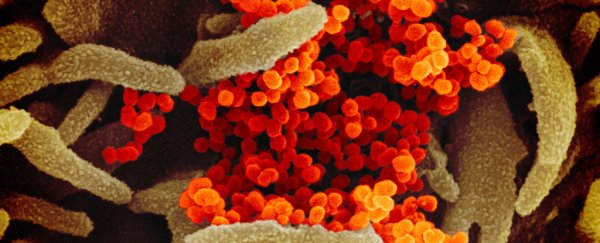Scientists have discovered which kinds of cells in the human body may be most susceptible to infection by the SARS-CoV-2 virus, identifying putative targets for the pathogen based on the types of proteins produced by cells.
During the original SARS epidemic in the early 2000s, researchers found that the virus responsible, officially designated SARS-CoV, infects cells with the help of two proteins: a receptor called angiotensin-converting enzyme 2 (ACE2), which helps the virus bind to cells, and an enzyme called Type II transmembrane serine protease (TMPRSS2), which mediates the infection of the cell.
Earlier this year, scientists discovered that SARS-CoV-2 - the one that causes COVID-19 - exploits the same two proteins, giving researchers a vital clue to identify the most susceptible targets of the virus at the cellular level: cells in respiratory and intestinal tissue that express both ACE2 and TMPRSS2.
"As soon as we realised that the role of these proteins had been biochemically confirmed, we started looking to see where those genes were in our existing datasets," says immunologist Jose Ordovas-Montanes from Boston Children's Hospital.
"We were really in a good position to start to investigate which are the cells that this virus might actually target."
In a huge, multi-institutional effort involving dozens of scientists, researchers combed through multiple RNA-sequencing datasets, compiling information for thousands of different kinds of cells in humans, non-human primates, and mice.
In particular, the team were looking for gene expression patterns for hundreds of cell types in the lungs, nasal passages, and intestine – areas of the body that we know can harbour SARS-CoV-2.
"Because we have this incredible repository of information, we were able to begin to look at what would be likely target cells for infection," says chemical physicist Alex Shalek from MIT.
"Even though these datasets weren't designed specifically to study [ SARS-CoV-2], it's hopefully given us a jump start on identifying some of the things that might be relevant there."
Ultimately, the analysis revealed that only a small minority of human respiratory and intestinal cells have genes that express both ACE2 and TMPRSS2.
Amongst the ones that do, three main cell types were identified: lung cells called type II pneumocytes (which help maintain air sacs, known as alveoli); intestinal cells called enterocytes, which help the body absorb nutrients; and goblet cells in the nasal passage, which secrete mucus.
Whether both ACE2 and TMPRSS2 need to be on the same cell, or if soluble forms of TMPRSS2 can float around and do the same job, remains an area for future research. The researchers say knowing the cell types that make the most obvious targets could be a big help for future work, including investigations toward the development of potential antiviral drugs to fight the pandemic.
"This may not be the full story, but it definitely paints a much more precise picture than where the field stood before," explains Ordovas-Montanes.
"Now we can say with some level of confidence that these receptors are expressed on these specific cells in these tissues."
Among the new results, the team also made a puzzling discovery. A family of immune proteins called interferons, which usually help the body to fight off infections, turns out to stimulate the ACE2 gene that produces the ACE2 protein.
Just why that is remains unknown, but it means that one of our body's natural defence mechanisms against pathogens, in this instance, could actually end up promoting SARS-CoV-2, by up-regulating production of the receptor the virus uses to cling on to cells.
If so, it could be an example of a sneaky evolutionary adaptation, although the researchers say there's a lot more work to be done to figure out what's going on here.
"This isn't the only example of that," Ordovas-Montanes explains.
"There are other examples of coronaviruses and other viruses that actually target interferon-stimulated genes as ways of getting into cells. In a way, it's the most reliable response of the host."
